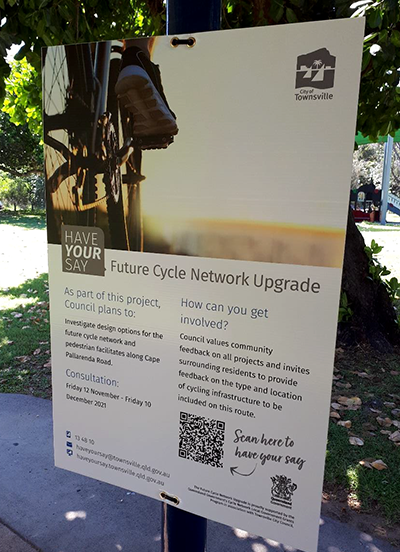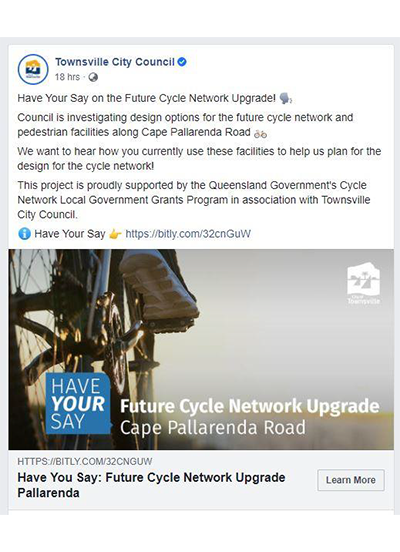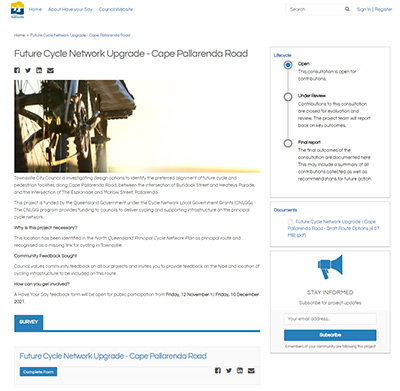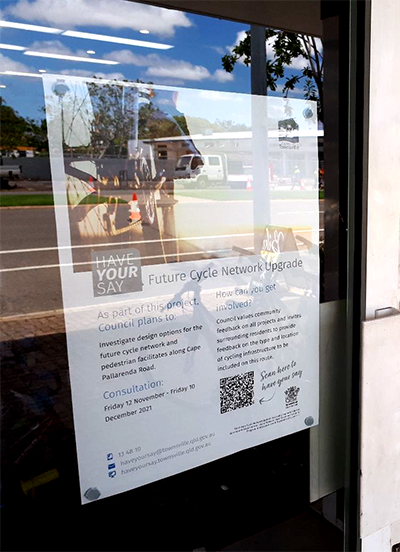Cape Pallarenda Road Future Cycle Network Upgrade — Community engagement case study
Townsville City Council's approach to engagement for the Cape Pallarenda Road Future Cycle Network Upgrade demonstrated how early community consultation can help set a project up for future success. This case study explores how Townsville City Council developed its public consultation plan, what activities were implemented and the benefits and outcomes achieved.
Background
Cape Pallarenda Road is a principal route in the North Queensland Principal Cycle Network Plan and is recognised as a missing link for bike riding in Townsville.
In late 2021, Townsville City Council commenced a project to investigate design options and identify the preferred alignment of future cycle and pedestrian facilities along Cape Pallarenda Road between the Bundock Street/Heatleys Parade intersection and The Esplanade/Marlow Street intersection, Pallarenda.
The project was co-funded by the Queensland Government under the Cycle Network Local Government Grants program.
To inform project planning, Townsville City Council consulted the Department of Transport and Main Roads' (TMR) Active Transport Investment Program Community and Stakeholder Engagement Guide, which highlights the benefits of community engagement early in the project lifecycle.
Approach
Based on the Active Transport Investment Program Community and Stakeholder Engagement Guide, Townsville City Council identified an opportunity to engage with the community early in the project to:
- ensure interested community members were aware of the project
- create a sense of ownership for the project and take stakeholders along the route analysis and design options journey
- capture expertise, local knowledge, ideas and feedback early, to help strengthen project outcomes
- establish and strengthen relationships with bike riding stakeholders.
Townsville City Council identified the project as having a low-moderate localised impact. Following the 5-step process outlined in the guide, the project team devised a public consultation plan comprising two phases of engagement between August 2021 and January 2022.
As traditional face-to-face engagement activities were not an option due to the ongoing impacts of COVID-19, the project team embraced the opportunity to transition to digital engagement by replacing in-person workshops with webinars.
The guide also supported Townsville City Council to select tools and activities that were appropriate for the desired level of engagement with each stakeholder group. This included digital media channels to disseminate project messaging, as well as digital tools and platforms to capture community feedback.
In phase 1, Townsville City Council engaged with stakeholders identified as having a high interest or high influence in the project through:
- direct mail to directly affected property owners and Aboriginal and Torres Strait Islander groups, followed by one-on-one meetings
- direct mail to neighbouring businesses and property owners, cycling reference and bicycle user groups, and other community and special interest groups, followed by webinars with these stakeholders.
These activities:
- gave key stakeholders the opportunity to learn about the project and discuss their needs, concerns and questions directly with the project team and prior to broader public consultation
- provided a forum for more detailed information about the project location's characteristics, constraints and best practice design treatments, to be shared and discussed with key stakeholders
- enabled the project team to:
- establish robust relationships with key stakeholders at project commencement
- garner the support of the local bicycle user group to circulate project information to their members and networks as part of phase 2.
In phase 2, Townsville City Council expanded its engagement to ensure members of the broader community were aware of the project and the opportunity to provide feedback. Activities and their benefits included:
- media release and targeted social media posts – raised awareness of the project and connected audiences outside the immediate project area to the Have Your Say Townsville page for more information and to contribute feedback
- corflute signage and posters placed along the route and in nearby bike shops – helped to reach local residents, existing bike riders and community members who may not be active online but likely to have the greatest interest in the project
- project page, online feedback form on Townsville City Council's Have Your Say Townsville digital engagement platform and project-specific email address – provided anytime, anywhere access for the community to read more about the project, submit their comments or email the project team directly
- one-on-one meetings and workshops – allowed the project team to continue discussions with property owners and key stakeholder groups to ensure they were included on the journey as the project progressed and evolved.




Results and outcomes
The activities Townsville City Council implemented were successful in achieving the objectives of its public consultation plan. There was very high community uptake of the online feedback form, with the project achieving one of the highest response rates Townsville City Council has achieved since conducting consultations via the Have Your Say Townsville platform.
Overall, the consultation found a significant level of support for upgrading cycle networks in Pallarenda.
Key learnings
Townsville City Council's engagement approach for this project demonstrates the value of engaging early with stakeholders and the importance of maximising feedback from community members affected or impacted by the project.
- During the webinar with the local Bicycle User Group (BUG), the BUG offered to distribute the project information to its members, which resulted in a large proportion of online feedback respondents being existing bike riders.
- The online feedback form allowed the project team to hear about people's lived experiences of riding in Townsville and their suggestions as the likely primary users of the future cycle route. This kind of user feedback can often be very valuable to help justify future design recommendations and investment decisions.
- The amount and quality of feedback obtained through all the engagement mechanisms surpassed the project team's expectations and indicated a strong desire from the community to be involved during project planning.
It also highlights how early engagement benefits everyone:
- Key stakeholder groups appreciated being involved early in the planning and the overwhelming response to the online consultation provided the project team a much greater appreciation of key issues along the link.
- Stakeholder and community insights will assist Townsville City Council to develop the best infrastructure solution which aligns with both project objectives and community needs and expectations, while also helping prevent the need for potential future re-work during later project stages.
- The early engagement approach created a good foundation for the project team to continue to have open and robust discussions with stakeholders throughout future project stages. It also enabled team members to establish several new relationships which will be valuable for other similar projects.
Next steps
Townsville City Council recognises closing the loop with key stakeholders and the community is an important aspect of accountability and transparency. Plans are underway to acknowledge key stakeholders and registered respondents for participating in the consultation process, as well as update the Have Your Say Townsville project page with the consultation outcomes.
As the project moves into the design stage, Townsville City Council will continue to actively engage with stakeholders and community, building on the strong relationships established and proven engagement techniques used during the options analysis.
Stakeholders will be invited to participate in workshops and the community will be invited to provide feedback through online consultation forums, with the aim of reaching consensus on a preferred route and design treatment options at the end of the design stage.
- Last updated 07 October 2022

